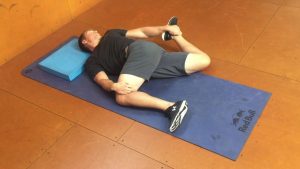How Accurate Is That Test?
Physical assessment is considered one of the most accurate ways to assess function of the locomotor tissues of the body. While we can often gain valuable information about structural problems through high-tech diagnostic procedures like X-ray or MRI, these procedures tell us very little about the function of the tissues involved in creating and limiting movement.
Some of the most detailed information practitioners gather from physical examination comes from a group of procedures called special tests. This group includes methods such as active range of motion; passive range of motion; manual resistive tests; and special regional orthopedic tests. The special regional orthopedic test is a particularly important element of the assessment process. This test is designed to give information about a particular injury or condition.
A practitioner’s success in identifying a client’s problem is often directly related to his/her ability to perform good assessment procedures such as special regional orthopedic tests. The practitioner must be able to perform the test correctly. Other factors also come into play in determining how effective that assessment procedure is, and consequently how effective the practitioner is at identifying the client’s problem.
Accuracy in special regional orthopedic tests is affected by the relationship of two related concepts – sensitivity and specificity of the test. Sensitivity is the percentage of subjects with the condition who also show a positive result on the test. It determines how “sensitive” (accurate) the test is at determining the condition when it is present. Specificity is the percentage of subjects without the condition who show a negative result on the test. It determines whether the test can show if someone doesn’t have the condition.
Take as example a sample of people in an experiment: some with carpal tunnel syndrome, and some without. If a special regional orthopedic test like the Phalen’s test is performed, and everyone tests positive for carpal tunnel syndrome, it means that everyone in this group who had carpal tunnel syndrome got a positive test. The sensitivity of the test in this instance is considered high. However, all the people who don’t have carpal tunnel syndrome also tested positive; there were no negative tests, even for people without the condition. Therefore, this test’s specificity is low.
Certain commonly utilized special orthopedic tests may not have a high degree of sensitivity or specificity, yet are frequently used as guidelines for evaluating the presence of a particular condition. A good example of this is Adson’s maneuver, used for identifying thoracic outlet syndrome. To perform Adson’s maneuver, the practitioner finds the client’s radial pulse at the wrist, then brings the client’s arm back into extension and lateral rotation. The client is instructed to look over his/her shoulder toward the affected side and take in a deep breath. If the intensity of the pulse diminishes, the client is suggested to have entrapment of the brachial plexus and subclavian artery by the anterior and middle scalene muscles — commonly referred to as thoracic outlet syndrome. The problem with this procedure is that a large number of people who do not have any symptoms test positive (diminishing radial pulse) when this test is performed. Thus, this test does not have a high degree of specificity.
The most accurate special regional orthopedic tests have high degrees of specificity and sensitivity; however, this is not always easy to demonstrate. Many studies attempt to evaluate the effectiveness of different assessment procedures, and to illustrate the strengths and weaknesses of each. The more you know about the clinical accuracy of these procedures, the more capable you are of identifying your client’s primary complaint.
Ready to #feelbetter?
You're just a click away from a wicked good massage!
-

60 Minute Massage Gift Card
$170.00 Add to cart -

90 Minute Massage Gift Card
$255.00 Add to cart -

Mini Aer Small Room Air Purifier
$149.00 Add to cart -
Sale!

Thera-Pearl Sports Pack/Hot Cold
Original price was: $14.99.$12.99Current price is: $12.99. Add to cart -

3 Somadome Sessions Gift Card
$135.00 Add to cart -
Sale!

TheraBand® Stretch Strap
Original price was: $19.99.$14.99Current price is: $14.99. Add to cart -

20 Minute Somadome Gift Card
$45.00 Add to cart -

TheraBand CLX Connective Loop
$14.99 Select options
Please Hold the R.I.C.E.
Please Hold the R.I.C.E. I have been in the rehabilitation field since 1992. Since the very beginning I was always told that when treating an acute injury you should follow the age old acronym of R.I.C.E. or Rest, Ice, Compression and Elevation. The concept was originally introduced by one of the most respected names in…
Read MoreHave a Brettzel!
Have a Brettzel! In the world of flexibility and stretching, there are a bevy of stretches that have likely been shown to you over the years. It’s hard to remember them if you don’t consistently do them and the ones you likely DO recall are the ones that are probably easiest for YOU to perform.…
Read MoreTake 5: A Stress Break
Take 5: A Stress Break I will be the first in line to inform you of the benefits of a 60 minute massage treatment. However, what if your massage is not scheduled for another week or worse, not even scheduled? Well, as a firm believer and trumpeter of self-care, here is a pretty neat trick…
Read MoreIs it a Muscle Cramp or Muscle Strain?
Is it a Muscle Cramp or Muscle Strain? Last week when my daughter walked in from cheerleading practice, I noticed her limping. When I asked her why she was limping, she went on to explain what I often hear and have seen from my athletes. Having been fortunate to evade serious injuries until this point…
Read MoreWork From Home Hacks!
With so many of you experiencing a new work environment, you are probably starting to notice that many of the chronic aches and pains you had experienced in the past at work on a daily basis, have seemingly disappeared. In their place however, are a new set of sensations we are experiencing due to such…
Read MoreHow to Fold a Fitted Sheet
Have a ‘sheety’ Valentine’s Day! Today is Valentine’s Day, otherwise known to most as a #greetingcardholiday. As I walked out of CVS this morning, I laughed at the people who were fighting for position in the greeting card aisle. Valentine’s Day is about showing love for someone in your life, not elbowing strangers while cursing…
Read MoreHappiness is Contagious
Happiness is Contagious Maybe mom was right. Research suggests that surrounding yourself with friends and family who are happy can actually increase your own happiness. Scientists at Harvard University and the University of California, San Diego, found that emotions, particularly happiness, have a viral effect in how they spread from one person to another. For…
Read MoreDe-stressing the Commute
De-stressing the Commute Turning Road Rage into Road Sage The average American commuter spends an hour a day driving to and from work. During this stressful, stop-and-go time, it’s likely that blood pressure increases, adrenaline begins pumping, and muscles constrict and tighten. By the time you get home, you’re wiped out and grumpy, and you…
Read MoreWhat’s the Scoop on your Poop?
What’s the Scoop on your Poop? Being the father of two girls, I know I have my work cut out for me. I have come to accept that there are lessons that I can teach my children and there are others lessons they will simply have to learn through personal experience. One of the lessons…
Read MoreHalloween Hacked!
Halloween Hacked Check out these simple hacks! Who among us doesn’t love Halloween. If I am being honest, it used to be me! You see, I typically found myself in trouble around this time of year when I was in grammar school. Let’s just say that I wasn’t always motivated to do what was asked…
Read More








